 |
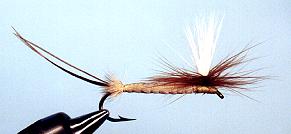 "Robert's Drake" Photos by Jim Birkholm
|
|
|
Materials List:
Thread: Yellow, size 3/0 down to # 12 hooks; size 6/0 or 8/0 #14 hooks and smaller. Tail: Pheasant tail fibers [may substitute moose body hair]. Body: Light tan hair [preferably from young deer for the smaller sized flies]; yellow thread is "crosshatched" when wrapping the body. Wing: Upright tuft of white deer belly fur [preferably from young deer for the smaller sized flies]; occasionally substituted with good quality calftail for larger sizes and good quality calf body for smaller sizes. Hackle: Medium ginger tied parachute; frequently substituted with "red" [brown].
Tying Instructions:Flies tied by Sam Surre [4-step flies] and Josh Nethers [full-bodied sample]. 1. Wrap the hook with thread and tie in pheasant tail fibers [or moose body hair substitute]. Generally, several fibers are tied in; for larger flies, 4 or 5 tail fibers may be tied-in. After securing the tail fibers, wrap the thread forward to near the eye of the hook.
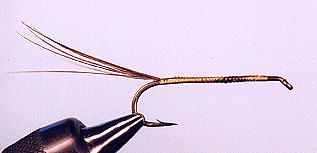 2. Select light colored deer body hair, longer than the length of the hook shank [though darker hair may be selected for darker bodied mayflies, like the brown drake]. Do not stack the hair. Place the hair along the hook with the tips of the hair extended about ½ the size of the gap beyond the bend of the hook; trim to length [just behind the eye of the hook] and secure the hair firmly at the 'head'.
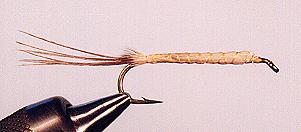 3. Holding the hair firmly along hook, wrap the body from the front back to the bend of the hook. While securing the deerhair at the bend of the hook, give the thread a firm tug so as to make the deerhair that extends back beyond the hook to flair slightly. Wrap the thread forward to the front of the hook, cross-hatching the wraps already made, then half-hitch.
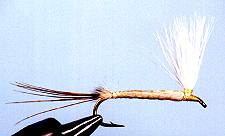 4. Measure and cut white deer-hair to approximately ¾ length of the shank of the hook [may be slightly longer for after-dark fishing to increase visibility]. Tie-in white hair for the parachute post [wing].
 5. Hackle in the parachute style, using two ginger [or red-brown] hackles. Tie in and wrap down the post, 3 or 4 wraps. Half-hitch to secure. 6. Wrap the head and conclude with a whip-finish knot. 7. NOTE: Particularly for fishing at or after dark, when fishing for bigger browns, many fly-fishers prefer a very full bodied Roberts Drake pattern, with an ample amount of deerhair for the body. These fuller deer-hair bodied are especially buoyant, an important factor when using x-heavy wire hooks.
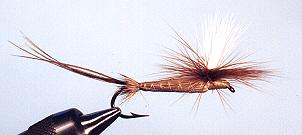 |
[ HOME ]
[ Search ] [ Contact FAOL ] [ Media Kit ]